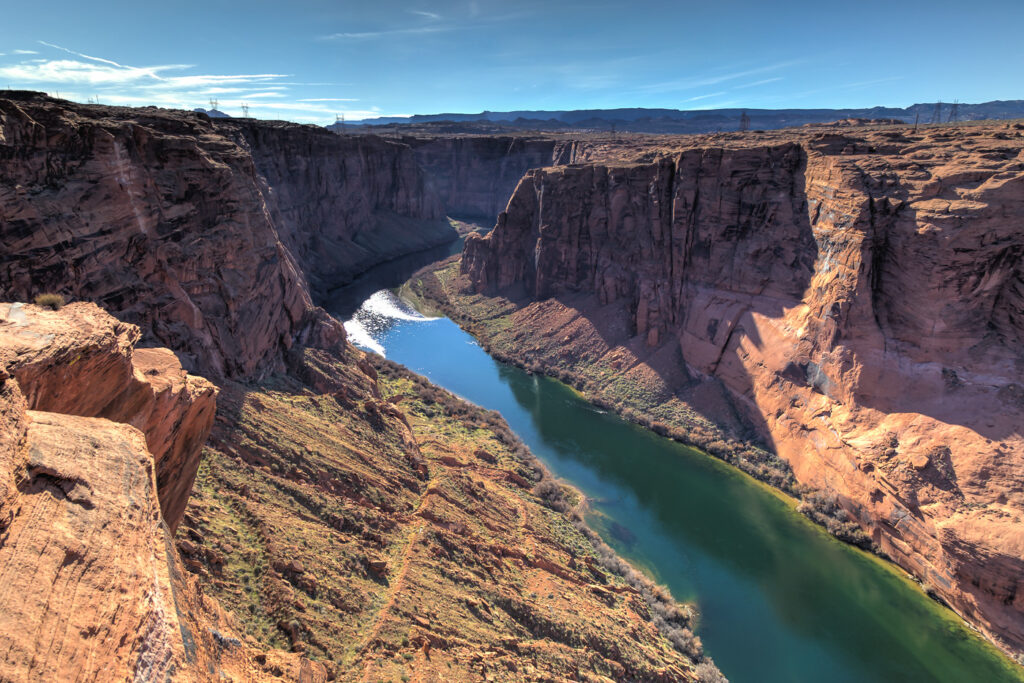
This article was originally published in High Country News.
It’s now clear that the Colorado River simply does not deliver as much water as we take from it. Fast, dramatic cuts—totaling up to 30% of all the water currently in use—are needed now if we’re going to avoid the “deadpool” conditions in Lake Mead and Lake Powell that would trap any remaining water behind dams. The urgency is clear, yet the seven Colorado River Basin states have repeatedly failed to agree on how to share the cuts.
On Oct. 12, the Department of the Interior announced one step toward a solution: the Lower Colorado Conservation and Efficiency Program. The program invites water users to propose new water conservation projects. In return, they’ll receive some of the $4 billion in the Inflation Reduction Act that’s been earmarked for water conservation in the West. Two parts of the program focus on short-term action for the immediate crisis; the third is focused on longer-term solutions.
There is a lot to like about Interior’s new program. It will help to reduce conflict by paying for voluntary conservation. One part offers a fixed price of $330 to $400 per acre-foot, making it easier for farmers, irrigation districts, tribes, and cities to decide whether (and how much) they want to participate at that price. The other part allows water users to propose both conservation actions and their asking price for agreeing to these actions. Water users will get to choose whether to opt in to cutbacks and at what level of compensation.
But the details are fuzzy. How much of the IRA funding will be allocated under the program, and how much will go to each component of it? How will proposals be selected? What happens if the program fails to attract enough conservation? Without clear answers, water users may be just as hesitant as they have been all summer, waiting for others to make the first move while hoping to get a better deal later on. This new program fails to meet the urgency of the current crisis.
There is another way to swiftly resolve the shortage—at least temporarily—while minimizing pain, conflict, and economic harm. Interior should spend the bulk of its IRA funds by conducting what’s called a reverse auction.
In most auctions, people bid what they are willing to pay to acquire something. Here, water users would bid what they are willing to accept in order to forgo a certain quantity of water deliveries. The government would then accept the lowest bids. Many of the winning bids are likely to come from agriculture, which accounts for as much as 80% of water use.
A reverse auction would get Interior more “bang for its buck” than the fixed-price plan. Farmers would have an incentive to submit lower bids, increasing the chances that they will “win” and get paid. This leaves more money for Interior to accept more bids at higher prices, yielding more conservation. And the more conservation that Interior can achieve through voluntary means, the fewer uncompensated cuts will be needed in the future.
A reverse auction will be more successful if Interior decides to act now and use the bulk of the $4 billion authorized by Congress to pay farmers to cut their water consumption while making it clear that this is it: There will be no more rounds of negotiation or compensation programs in the next few years. This would encourage everyone to jump at the chance to be compensated now, rather than wait for a better deal later.
Interior can also help an auction succeed by spelling out precisely how much water must be cut and identifying who will be affected if voluntary conservation fails. So far, officials have been reluctant to commit to any exact plans. A clear backup plan would put an end to wishful thinking and lead water users to bid accordingly.
IRA funds should be more than enough to resolve all of next year’s shortage through an auction. A rough estimate based on recent prices for water leases suggests that $4 billion spent through an auction could achieve all necessary cutbacks for somewhere between two and seven years.
What’s more, many farmers in the West already have experience with reverse auctions. USDA’s Conservation Reserve Program uses reverse auctions to protect millions of acres of environmentally sensitive land every year. The Nature Conservancy uses a similar approach to secure temporary habitat for migratory birds by paying farmers to flood fields in California’s Central Valley.
We fear that Interior’s current plan, as announced, is set up for failure. Participation may be low, and the funding could be exhausted too early. We don’t have another six months to sort out who is going to conserve water while fish habitat evaporates, Lake Mead continues to drain, and the turbines in Glen Canyon Dam stutter to a stop. Instead, we can solve the water shortage now—and with the least possible pain—with an auction that gets the incentives right the first time around.




